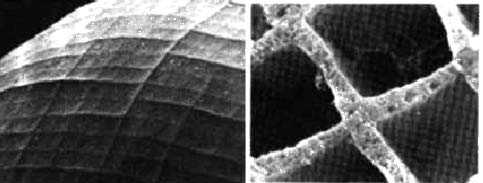 There are many different types of eye in the living world. We are accustomed to the camera-type eye found in vertebrates. This structure works on the principle of the refraction of light, which falls onto the lens and is focused on a point behind the lens inside the interior of the eye.
There are many different types of eye in the living world. We are accustomed to the camera-type eye found in vertebrates. This structure works on the principle of the refraction of light, which falls onto the lens and is focused on a point behind the lens inside the interior of the eye.
However, the eyes possessed by other creatures work by different methods. One example is the lobster. A lobster's eye works on a principle of reflection rather than that of refraction.
The most outstanding characteristic of the lobster eye is its surface, which is composed of numerous squares. As shown in the picture on the next page, these squares are positioned most precisely.
The eye of a lobster shows a remarkable geometry not found elsewhere in nature - it has tiny facets that are perfectly square, so it "looks like perfect graph paper."
These well-arranged squares are in fact the ends of tiny square tubes forming a structure resembling a honeycomb. At first glance, the honeycomb appears to be made up of hexagons, although these are actually the front faces of hexagonal prisms. In the lobster's eye, there are the squares in place of hexagons.
Even more intriguing is that the sides of each one of these square tubes are like mirrors that reflect the incoming light. This reflected light is focused onto the retina flawlessly. The sides of the tubes inside the eye are lodged at such perfect angles that they all focus onto a single point.

The extraordinary nature of the design of this system is quite indisputable. All of these perfect square tubes have a layer that works just like a mirror. Furthermore, each one of these cells is sited by means of precise geometrical alignments so that they all focus the light at a single point.
It is obvious that the design in the lobster eye presents a great difficulty for the theory of evolution. Most importantly, it exemplifies the concept of "irreducible complexity." If even one of its features - such as the facets of the eye, which are perfect squares, the mirrored sides of each unit, or the retina layer at the back - were eliminated, the eye could never function. Therefore, it is impossible to maintain that the eye evolved step-by-step. It is scientifically unjustifiable to argue that such a perfect design as this could have come about haphazardly. It is quite clear that the lobster eye was created as a miraculous system. One can find further traits in the lobster's eye that nullify the assertions of evolutionists. An interesting fact emerges when one looks at creatures with similar eye structures. The reflecting eye, of which the lobster's eye was one example, is found in only one group of crustaceans, the so-called long-bodied decapods. This family includes the lobsters, the prawns and the shrimp.
One can find further traits in the lobster's eye that nullify the assertions of evolutionists. An interesting fact emerges when one looks at creatures with similar eye structures. The reflecting eye, of which the lobster's eye was one example, is found in only one group of crustaceans, the so-called long-bodied decapods. This family includes the lobsters, the prawns and the shrimp.
The other members of the crustacea class display the "refracting type eye structure", which works on completely different principles from those of the reflecting type. Here, the eye is made up of hundreds of cells like a honeycomb. Unlike the square cells in a lobster eye, these cells are either hexagonal or round. Furthermore, instead of reflecting light, small lenses in the cells refract the light onto the focus on the retina.
The majority of crustaceans have the refracting eye structure. On the contrary, only one group of the crustaceans, namely the long-bodied decapods, have reflecting eyes. According to evolutionist assumptions, all the creatures within the class Crustacea should have evolved from the same ancestor. Therefore, evolutionists claim that reflecting eye evolved from a refracting eye, which is far more common among the crustacea and of a fundamentally simpler design.
However, such reasoning is impossible, because both eye structures function perfectly within their own systems and have no room for any "transitional" phase. A crustacean would be left sightless and would be eliminated by natural selection if the refracting lens in its eye were to diminish and be replaced by reflecting mirrored surfaces.
It is, therefore, certain that both of these eye structures were designed and created separately. There is such superb geometric precision in these eyes that entertaining the possibility of "coincidence" is simply ludicrous. Just like the rest of the miracles of creation, the lobster's eye structure is an open testimony to the Creator's boundless power to create flawlessly. This is nothing but a manifestation of God's endless knowledge, wisdom and might. We can encounter such miracles as these regardless of what we examine in the world of creation.



